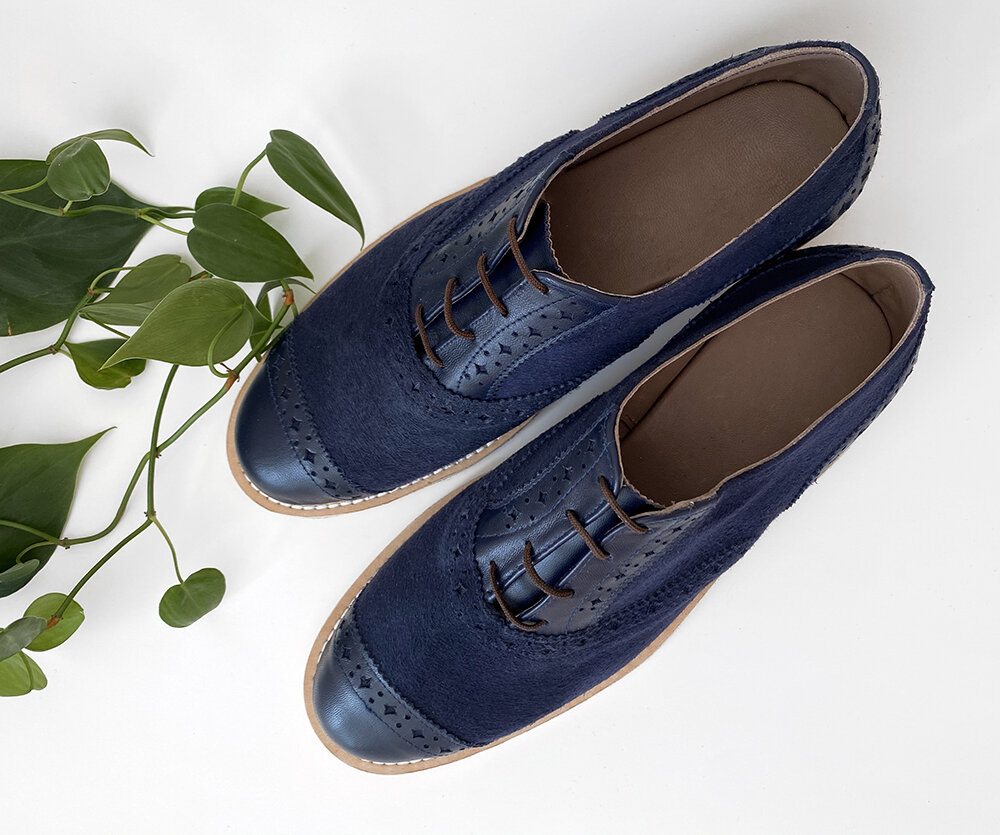Jessica Makes: Blue Suede Shoes
/Until up to about a month ago, I never, in my wildest dreams, thought I’d be able to make a pair of shoes at home with my regular sewing machine and that they would be cute and wearable. I always thought home shoemaking was limited to espadrilles and moccasins sewn by hand. Fast forward to now and I’ve just finished my first pair of Brogue Oxfords out of leather and I’m really chuffed with the final result.
Whenever I try something new I like to take a class (like I did with knitting and millinery), so after following I Can Make Shoes on Instagram for a while, I signed up to take the Boot Making online class. I went through the curriculum a couple of times while I waited for my supplies to arrive from overseas, while also knowing that I’d also need to make a trip to Indianapolis to pick up leather. Me and my parents were in Indy for a while this January, so my mom and I went to Landwerlen’s Leather Supply together and it was amazing. We had such a good time picking out leathers and one of the hides I found was this lovely navy lambskin.
I’d been sketching out a lot of boot ideas when I mentioned the idea of making this style of shoe to my dad. I remember watching him shine is own shoes when I was a kid and the Oxford style always reminds me of him. I just kept thinking about it in navy, so instead of forcing myself to carry on with my boot plans, I went back to YouTube and watched as many videos of Oxford shoemaking as I could find. Granted, they’re all professionals or factory settings, but combining those videos with the ICMS course, I felt confident enough to get started. (I filmed a little bit of this and posted it on my Instagram)
First I made my own pattern by taping up my last (shoe mold) and drawing up the design. From there I made a mock up out of felt just to get a grip on the underlaps and proportions. One thing about leather is that you’ve only got one shot at sewing it properly, so it’s good to have your fitting and planning squared away before you begin. But I’m getting a little ahead of myself because I also did my broguing (hole punching… and don’t quote me on that because I’m not sure it’s the technical term) before I sewed anything together. So it was a lot of measuring and a couple re-dos until I had my uppers stitched together.
I then made a lining pattern, stitched it together and sewed it to my upper. For those of you interested in further detail, I really suggest signing up for a class or doing some research/reading. If you’re the kind of person that likes to be very meticulous and has a grip on the engineering of garment construction, you’d definitely be able to make shoes. I wouldn’t call it hard, but definitely a challenge…the process humbled me quite a bit!
Once the upper and lining of the shoe are connected, the tongue sewn in and the lacing holes cut, the shoe now gets attached to the insole and sole. This involves a lot of glue and patience. I found cutting the thick leather for the sole and the heels and then smoothing it out, to be the most difficult part of the process. I felt good when I got the sole edges even, but professionals take it even further using hot tools, wax, even broken glass and dye to complete soles. I like the way these look now, but I’d love to continue learning so I can take my future pairs up a notch.
I made one shoe at a time, from start to finish. I learned a lot on my first shoe and made some improvements on the second. And next time, I’ll get even better!
I haven’t worn these out of the house yet (read: Midwestern winter) but when the sidewalks are clear and dry I’ll be giving these a spin. They’re very comfortable. Now I just need to decide what I’ll wear with them!




























